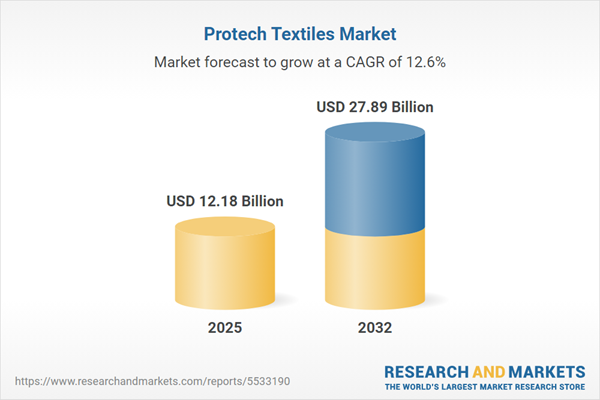Speak directly to the analyst to clarify any post sales queries you may have.
Senior leaders in highly regulated sectors are placing increased emphasis on advanced protective textiles as essential tools for managing operational risk, maintaining regulatory compliance, and strengthening resilience within critical infrastructure and workforce environments.
Market Snapshot: Protective Textiles Market Growth and Dynamics
The protective textiles market is expanding rapidly worldwide, with value forecasts showing notable acceleration between 2024 and 2032.
Growth is propelled by evolving safety regulations and compliance requirements, particularly across defense, energy, transportation, and manufacturing spheres. Organizations respond by adopting high-performance fibers and implementing advanced textile manufacturing technologies that enable them to adapt to heightened operational standards. The market is further shaped by innovation in supply chains, notably through the integration of smart textiles and expanded partnerships at the regional level. These shifts support infrastructure reliability and minimize vulnerabilities, especially in environments where continuous operation is vital. Regional strategies allow stakeholders to address regulatory challenges more effectively and ensure supply chains remain both secure and adaptable.Scope & Segmentation of the Protective Textiles Market
This report is structured to aid executive decision-making and procurement planning through a comprehensive analysis of the protective textiles market, reflecting the latest in technology adoption, regional trends, and compliance drivers:
- Material Types: Includes advanced aramid fiber, carbon fiber, glass fiber, nylon, polyester, PE, and wool. These materials are chosen for their proven protective qualities in hazardous environments where performance under stress is critical.
- Product Categories: Encompasses ballistic resistant, cut resistant, flame resistant, and high-temperature textiles. Each product line targets sector-specific requirements for personnel protection in defense, emergency response, security, and manufacturing applications.
- End-Use Applications: Involves protective apparel, energy systems components, specialized infrastructure, industrial machinery covers, and PPE. This range supports regulatory compliance and addresses unique workforce risk profiles across industries.
- Distribution Channels: Covers offline suppliers, dedicated ecommerce operators, digital marketplaces, and direct manufacturer links. Flexibility in sourcing platforms supports organizations aiming to keep pace with changing market expectations and procurement models.
- Regional Scope: Examines the Americas, EMEA, and Asia-Pacific, with focus on the United States, Canada, Brazil, Mexico, Germany, the UK, China, India, and Australia. Regional insight addresses jurisdictional regulatory differences, local risk factors, and compliance strategies tailored to each geography.
- Company Coverage: Features benchmarking and innovation highlights for Honeywell International Inc., DuPont de Nemours, Inc., Teijin Limited, Toray Industries, Kolon Industries, Royal TenCate N.V., Yantai Tayho Advanced Materials, Hyosung Corporation, Avient Corporation, and 3M Company. These examples illustrate best-in-class technology application and continuous process improvement.
Key Takeaways for Senior Decision-Makers
- Organizations integrating modern protective textiles achieve closer alignment of operational procedures with evolving compliance regulations, reducing exposure to risk and supporting stable business operations.
- The adoption of sensor-equipped and smart fiber solutions is leading to major improvements in safety management, enabling accurate real-time risk assessment and incident response in sensitive sectors.
- Enhanced quality assurance and traceability processes assure ongoing audit readiness and reinforce occupational safety for regulated workforces.
- Engagement with regionally based suppliers and partners diversifies supply chains, increasing organizational agility in response to regulatory, procurement, or geopolitical changes.
- Sustainability initiatives, such as renewable fiber integration and advanced recycling, are becoming a central component in industrial risk mitigation and support corporate responsibility commitments.
Tariff Impact on Supply Chain and Competitiveness
Shifts in United States tariff policies are prompting organizations to reconfigure sourcing, with a trend toward nearshoring and the implementation of digital procurement strategies. These adjustments help mitigate exposure to regulatory disruptions and improve consistency within widespread supply networks. Enterprises that advance these practices strengthen their competitive standing and minimize operational interruptions stemming from volatile supply chains.
Methodology & Data Sources
The findings in this report are grounded in direct discussions with technical professionals, senior executives, and industry regulators. Insights have been validated through rigorous review of academic research, corporate filings, and recognized market intelligence sources, ensuring actionable value for executive stakeholders.
Why This Report Matters
- Provides targeted guidance for translating industry change in protective textiles into decisive actions that build compliance and operational resilience.
- Supports executives in effectively leveraging advanced technologies and evolving sourcing strategies in line with regulatory expectations and industry standards.
- Offers a reliable foundation for organizations aiming to establish risk-aware, adaptable supply chains that respond to global uncertainties.
Conclusion
Early adoption of advanced protective textile technologies and diverse sourcing strategies strengthens organizational resilience. These approaches help sustain robust performance in industries where compliance and operational integrity are critical requirements.
Additional Product Information:
- Purchase of this report includes 1 year online access with quarterly updates.
- This report can be updated on request. Please contact our Customer Experience team using the Ask a Question widget on our website.
Table of Contents
3. Executive Summary
4. Market Overview
7. Cumulative Impact of Artificial Intelligence 2025
Companies Mentioned
The companies profiled in this Protech Textiles market report include:- Honeywell International Inc.
- DuPont de Nemours, Inc.
- Teijin Limited
- Toray Industries, Inc.
- Kolon Industries, Inc.
- Royal TenCate N.V.
- Yantai Tayho Advanced Materials Co., Ltd.
- Hyosung Corporation
- Avient Corporation
- 3M Company
Table Information
| Report Attribute | Details |
|---|---|
| No. of Pages | 196 |
| Published | October 2025 |
| Forecast Period | 2025 - 2032 |
| Estimated Market Value ( USD | $ 12.18 Billion |
| Forecasted Market Value ( USD | $ 27.89 Billion |
| Compound Annual Growth Rate | 12.5% |
| Regions Covered | Global |
| No. of Companies Mentioned | 11 |









